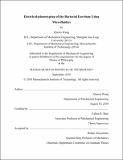| dc.contributor.advisor | Cullen R. Buie. | en_US |
| dc.contributor.author | Wang, Qianru, Ph. D. Massachusetts Institute of Technology | en_US |
| dc.contributor.other | Massachusetts Institute of Technology. Department of Mechanical Engineering. | en_US |
| dc.date.accessioned | 2019-02-05T15:17:53Z | |
| dc.date.available | 2019-02-05T15:17:53Z | |
| dc.date.copyright | 2018 | en_US |
| dc.date.issued | 2018 | en_US |
| dc.identifier.uri | http://hdl.handle.net/1721.1/120197 | |
| dc.description | Thesis: Ph. D., Massachusetts Institute of Technology, Department of Mechanical Engineering, 2018. | en_US |
| dc.description | This electronic version was submitted by the student author. The certified thesis is available in the Institute Archives and Special Collections. | en_US |
| dc.description | Cataloged from student-submitted PDF version of thesis. | en_US |
| dc.description | Includes bibliographical references (pages 109-118). | en_US |
| dc.description.abstract | The bacterial cell envelope is a complex multi-layered covering, crucial for cell viability and physiological capabilities. Phenotypic analysis of bacterial envelopes is challenging due to the small size and low cultivability of microbes. The emerging microfluidic techniques enable quantitative and nondestructive probing of cell envelopes by measuring their physical properties. This thesis demonstrates that phenotypic variations on bacterial envelopes change their surface polarizability-an intrinsic dielectric property-in a manner that can be distinguished by microfluidic dielectrophoresis (DEP). The three-dimensional insulator-based dielectrophoresis (3DiDEP), a microfluidic technique previously reported by our group, was optimized to explore the diverse surface phenotypes of bacterial electrochemical activity and lipopolysaccharide (LPS) biosynthesis. Electrochemically active bacteria transport electrons directly from their interior to external insoluble electron accepters, e.g. metal oxides or electrodes in electrochemical systems, via a process known as extracellular electron transfer (EET), holding an exciting promise in energy conversion and bioremediation. Using 3DiDEP, we demonstrate for the first time the strong correlation between microbial EET and cell surface polarizability, generalizable to three bacterial species with variant electrochemical activities, including Geobacter sulfurreducens, Shewanella oneidensis, and Escherichia coli heterologously expressing Shewanella EET pathways. We also applied 3DiDEP to achieve rapid quantification of LPS, the major component and virulence determinant in Gram-negative bacterial outer membrane. We examined E. coli mutant strains with various LPS components truncated, and show that structural diversity in LPS affects the trapping voltages required for 3DiDEP cell immobilization. Last but not least, we studied the interplay of electrothermal and induced charge electroosmosis (ICEO) flows, which can interfere DEP operations but are often overlooked in the design of iDEP systems. The effects of fluidic ionic strength, applied electric field, and insulating channel geometry on temperature rise and fluid velocities were investigated from a theoretical and experimental viewpoint. Taken together, this thesis introduces surface polarizability as a novel physical property for assessing microbial EET and LPS composition. Dielectrophoretic screening of bacterial envelope polarizability may unlock a vast repertoire of EET- and LPS- related biochemical applications, and will be useful as guidance for further DEP-based phenotypic analysis of a diverse array of cells and organisms. | en_US |
| dc.description.statementofresponsibility | by Qianru Wang. | en_US |
| dc.format.extent | 118 pages | en_US |
| dc.language.iso | eng | en_US |
| dc.publisher | Massachusetts Institute of Technology | en_US |
| dc.rights | MIT theses are protected by copyright. They may be viewed, downloaded, or printed from this source but further reproduction or distribution in any format is prohibited without written permission. | en_US |
| dc.rights.uri | http://dspace.mit.edu/handle/1721.1/7582 | en_US |
| dc.subject | Mechanical Engineering. | en_US |
| dc.title | Electrical-phenotyping of the bacterial envelope using microfluidics | en_US |
| dc.type | Thesis | en_US |
| dc.description.degree | Ph. D. | en_US |
| dc.contributor.department | Massachusetts Institute of Technology. Department of Mechanical Engineering | |
| dc.identifier.oclc | 1083219011 | en_US |
